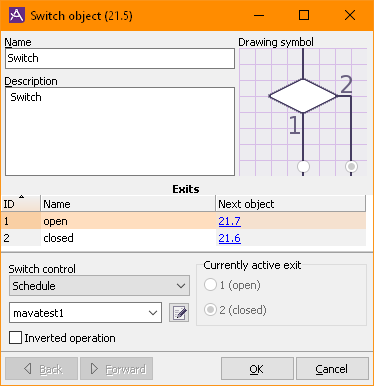A switch object routes the call flow to one of two different exits, numbered 1 or 2, depending on the state of the switch
.
Which exit is active can be set manually, by opening hours for IVR (schedules), or by opening hours for entrances or menu choices.

In addition to the standard properties of dialogue flow objects like the Name and Description, the following properties are also available:
- Exits
- The name of each of the two exits 1 and 2 can be changed.
- Switch control
- How the state of the switch is controlled:
-
If the controlling entity is a schedule or opening hours entity you have access to, you can view or edit it by clicking the edit button
 . If, however, it is not in the currently selected organisation area, you cannot view or edit the schedule / open hours, and this is indicated by a padlock icon
. If, however, it is not in the currently selected organisation area, you cannot view or edit the schedule / open hours, and this is indicated by a padlock icon  .
.If the switch is not manually controlled, this is also indicated with a clock icon, i.a. in the right-hand part of the Dialogue flows – main window.
Note that Entrances and Menu choices belongs to Organisation areas, so you must have access to the organisation area where the desired Entrance/Menu choice belongs to, and the correct organisation area must be selected to be able to select, view or edit them. - Currently active exit
- For Manual switch control, you can set which exit is to be active.
- Organisation area
- For Entrance or Menu switch control, you can change the organisation area if the current one isn't the one the desired Entrance or Menu choice belongs to.
- Inverted operation
- For Schedule switch control, you can tick this checkbox to
invert
the switch, i.e. make the switch open (exit 1 active) when the selected schedule is "closed".